Determining Job Satisfaction Influence on B&M Retail Employees
VerifiedAdded on 2020/07/22
|12
|3331
|52
Report
AI Summary
This report investigates the influence of flexible working conditions on employee job satisfaction and absenteeism at B&M Retail. The study reviews existing literature on job satisfaction, exploring factors such as rewards, discrimination, and social support. The research employs interviews and focus groups as primary data collection methods to gather insights from B&M Retail employees. The report identifies key issues, including the impact of flexible work arrangements on employee well-being and the effects of absenteeism on the organization. The analysis aims to provide recommendations for B&M Retail to improve employee satisfaction and retention, ultimately contributing to organizational success. The report also examines various factors impacting job satisfaction, such as the nature of tasks, relationships with supervisors, pay, and work conditions. The study concludes with recommendations for B&M retail on how to increase employee satisfaction and reduce absenteeism.
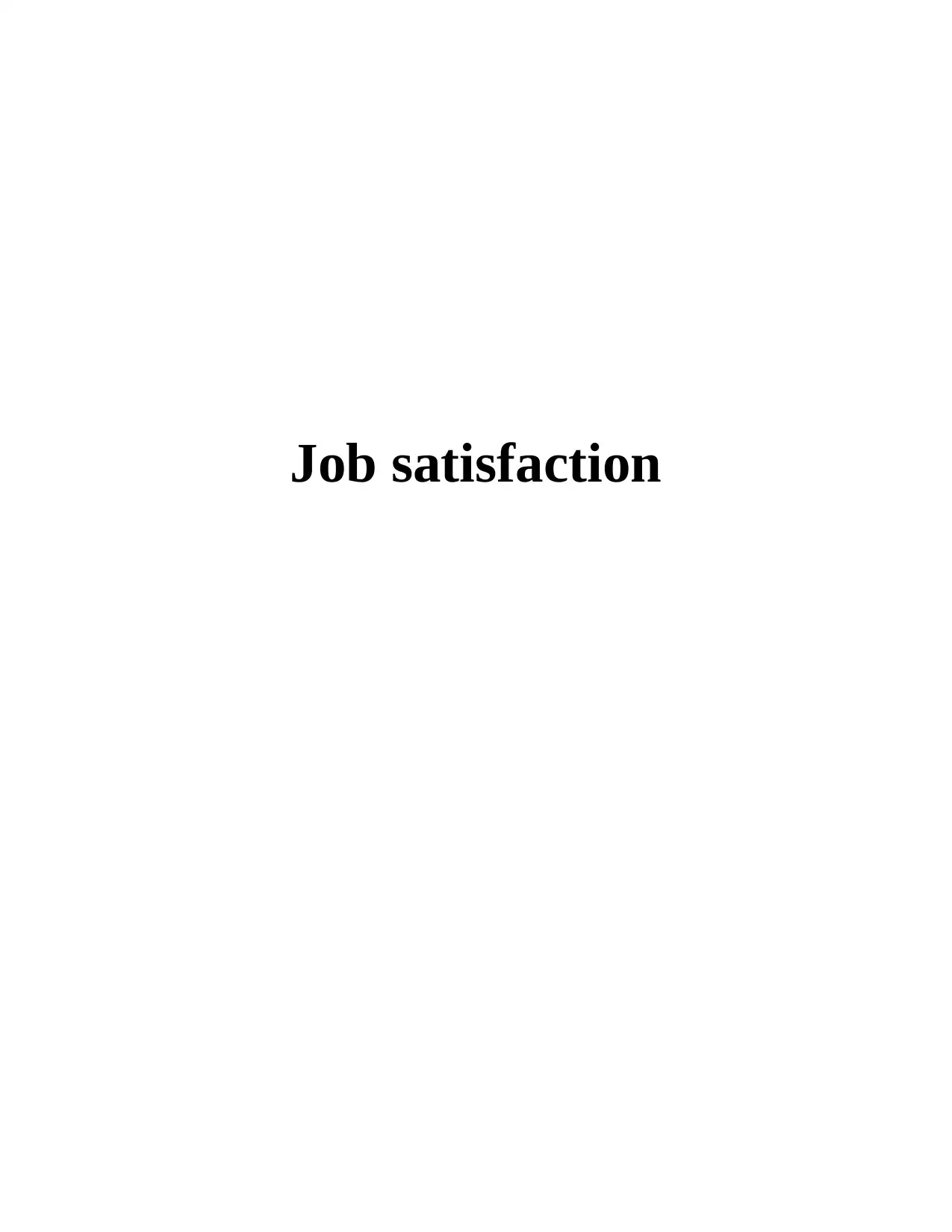
Job satisfaction
Paraphrase This Document
Need a fresh take? Get an instant paraphrase of this document with our AI Paraphraser
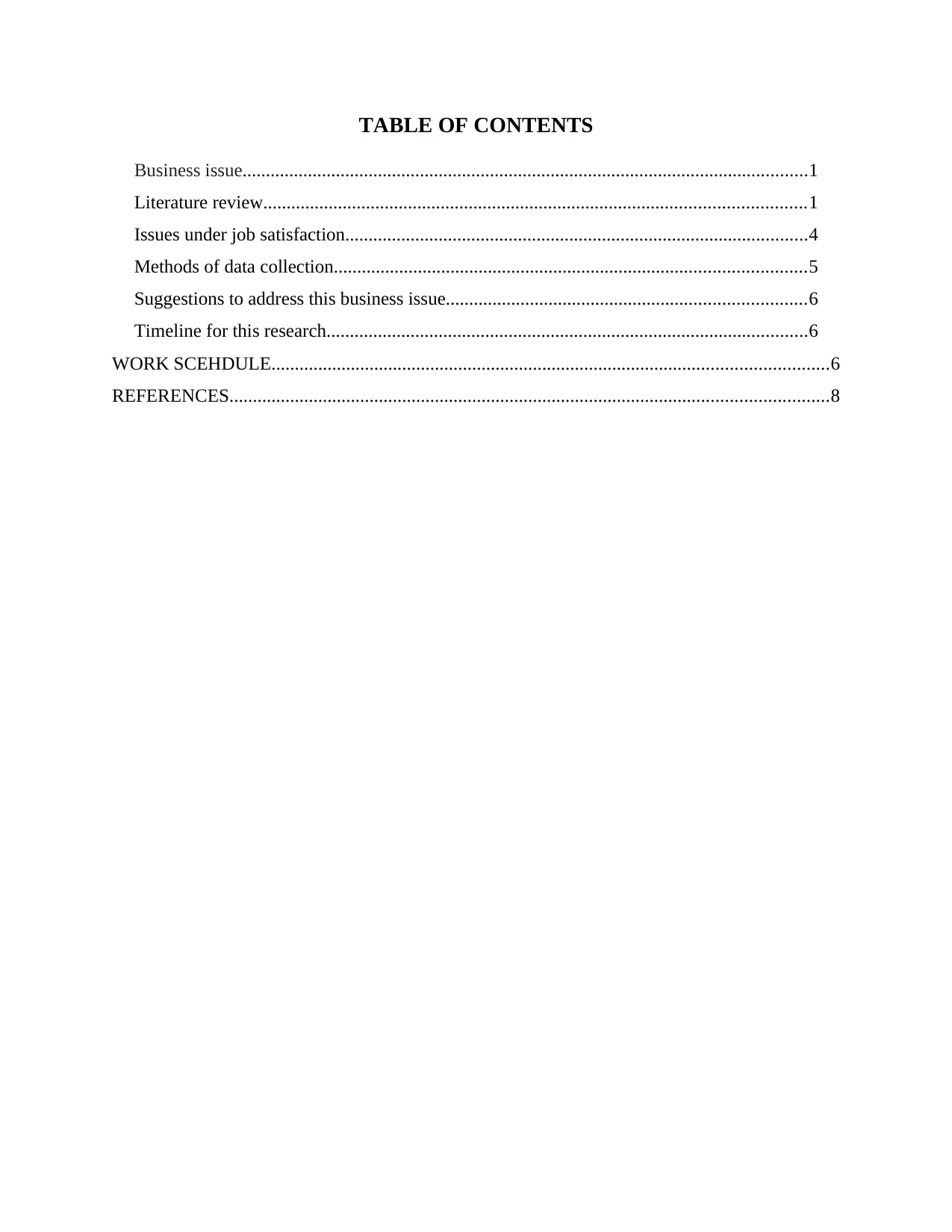
TABLE OF CONTENTS
Business issue.........................................................................................................................1
Literature review....................................................................................................................1
Issues under job satisfaction...................................................................................................4
Methods of data collection.....................................................................................................5
Suggestions to address this business issue.............................................................................6
Timeline for this research.......................................................................................................6
WORK SCEHDULE.......................................................................................................................6
REFERENCES................................................................................................................................8
Business issue.........................................................................................................................1
Literature review....................................................................................................................1
Issues under job satisfaction...................................................................................................4
Methods of data collection.....................................................................................................5
Suggestions to address this business issue.............................................................................6
Timeline for this research.......................................................................................................6
WORK SCEHDULE.......................................................................................................................6
REFERENCES................................................................................................................................8
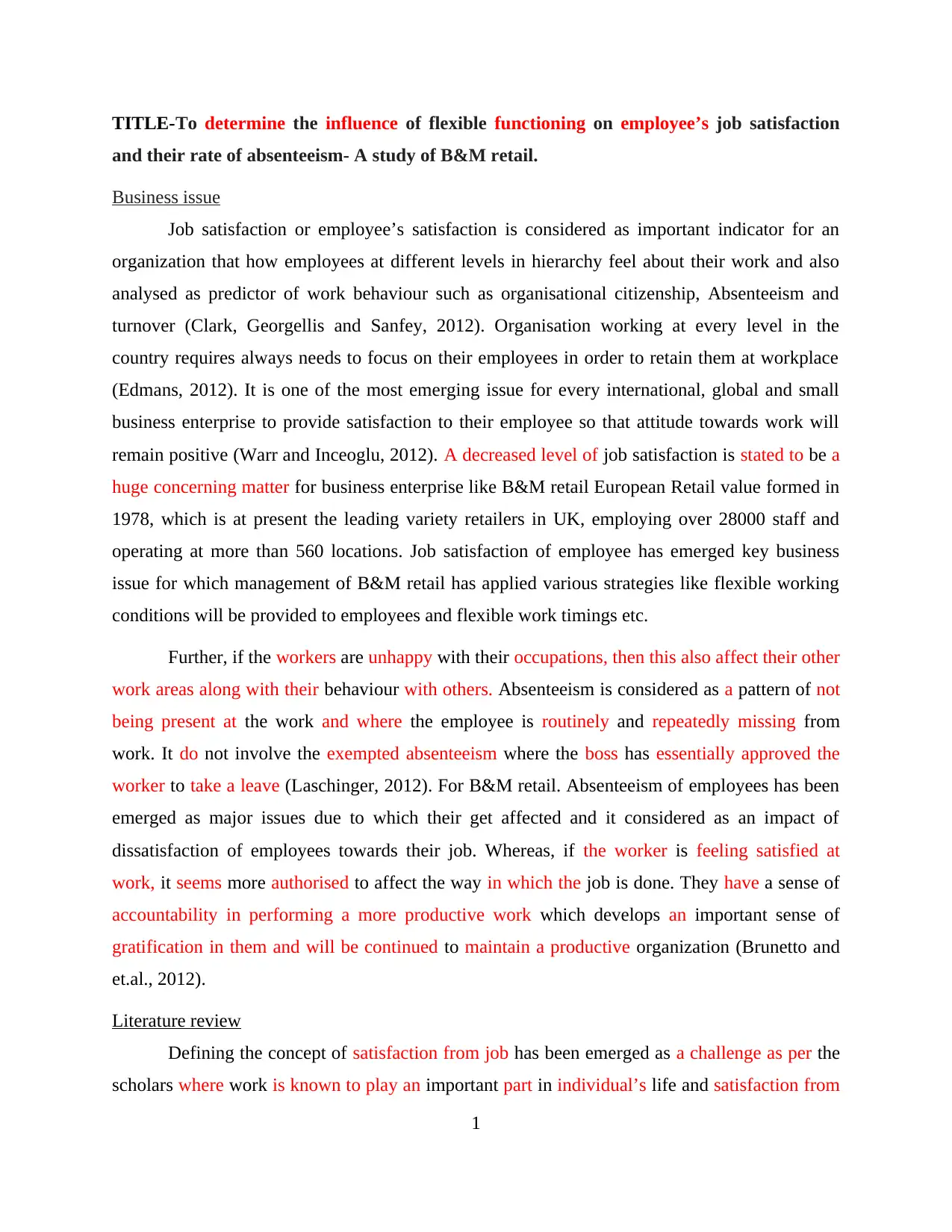
TITLE-To determine the influence of flexible functioning on employee’s job satisfaction
and their rate of absenteeism- A study of B&M retail.
Business issue
Job satisfaction or employee’s satisfaction is considered as important indicator for an
organization that how employees at different levels in hierarchy feel about their work and also
analysed as predictor of work behaviour such as organisational citizenship, Absenteeism and
turnover (Clark, Georgellis and Sanfey, 2012). Organisation working at every level in the
country requires always needs to focus on their employees in order to retain them at workplace
(Edmans, 2012). It is one of the most emerging issue for every international, global and small
business enterprise to provide satisfaction to their employee so that attitude towards work will
remain positive (Warr and Inceoglu, 2012). A decreased level of job satisfaction is stated to be a
huge concerning matter for business enterprise like B&M retail European Retail value formed in
1978, which is at present the leading variety retailers in UK, employing over 28000 staff and
operating at more than 560 locations. Job satisfaction of employee has emerged key business
issue for which management of B&M retail has applied various strategies like flexible working
conditions will be provided to employees and flexible work timings etc.
Further, if the workers are unhappy with their occupations, then this also affect their other
work areas along with their behaviour with others. Absenteeism is considered as a pattern of not
being present at the work and where the employee is routinely and repeatedly missing from
work. It do not involve the exempted absenteeism where the boss has essentially approved the
worker to take a leave (Laschinger, 2012). For B&M retail. Absenteeism of employees has been
emerged as major issues due to which their get affected and it considered as an impact of
dissatisfaction of employees towards their job. Whereas, if the worker is feeling satisfied at
work, it seems more authorised to affect the way in which the job is done. They have a sense of
accountability in performing a more productive work which develops an important sense of
gratification in them and will be continued to maintain a productive organization (Brunetto and
et.al., 2012).
Literature review
Defining the concept of satisfaction from job has been emerged as a challenge as per the
scholars where work is known to play an important part in individual’s life and satisfaction from
1
and their rate of absenteeism- A study of B&M retail.
Business issue
Job satisfaction or employee’s satisfaction is considered as important indicator for an
organization that how employees at different levels in hierarchy feel about their work and also
analysed as predictor of work behaviour such as organisational citizenship, Absenteeism and
turnover (Clark, Georgellis and Sanfey, 2012). Organisation working at every level in the
country requires always needs to focus on their employees in order to retain them at workplace
(Edmans, 2012). It is one of the most emerging issue for every international, global and small
business enterprise to provide satisfaction to their employee so that attitude towards work will
remain positive (Warr and Inceoglu, 2012). A decreased level of job satisfaction is stated to be a
huge concerning matter for business enterprise like B&M retail European Retail value formed in
1978, which is at present the leading variety retailers in UK, employing over 28000 staff and
operating at more than 560 locations. Job satisfaction of employee has emerged key business
issue for which management of B&M retail has applied various strategies like flexible working
conditions will be provided to employees and flexible work timings etc.
Further, if the workers are unhappy with their occupations, then this also affect their other
work areas along with their behaviour with others. Absenteeism is considered as a pattern of not
being present at the work and where the employee is routinely and repeatedly missing from
work. It do not involve the exempted absenteeism where the boss has essentially approved the
worker to take a leave (Laschinger, 2012). For B&M retail. Absenteeism of employees has been
emerged as major issues due to which their get affected and it considered as an impact of
dissatisfaction of employees towards their job. Whereas, if the worker is feeling satisfied at
work, it seems more authorised to affect the way in which the job is done. They have a sense of
accountability in performing a more productive work which develops an important sense of
gratification in them and will be continued to maintain a productive organization (Brunetto and
et.al., 2012).
Literature review
Defining the concept of satisfaction from job has been emerged as a challenge as per the
scholars where work is known to play an important part in individual’s life and satisfaction from
1
⊘ This is a preview!⊘
Do you want full access?
Subscribe today to unlock all pages.

Trusted by 1+ million students worldwide
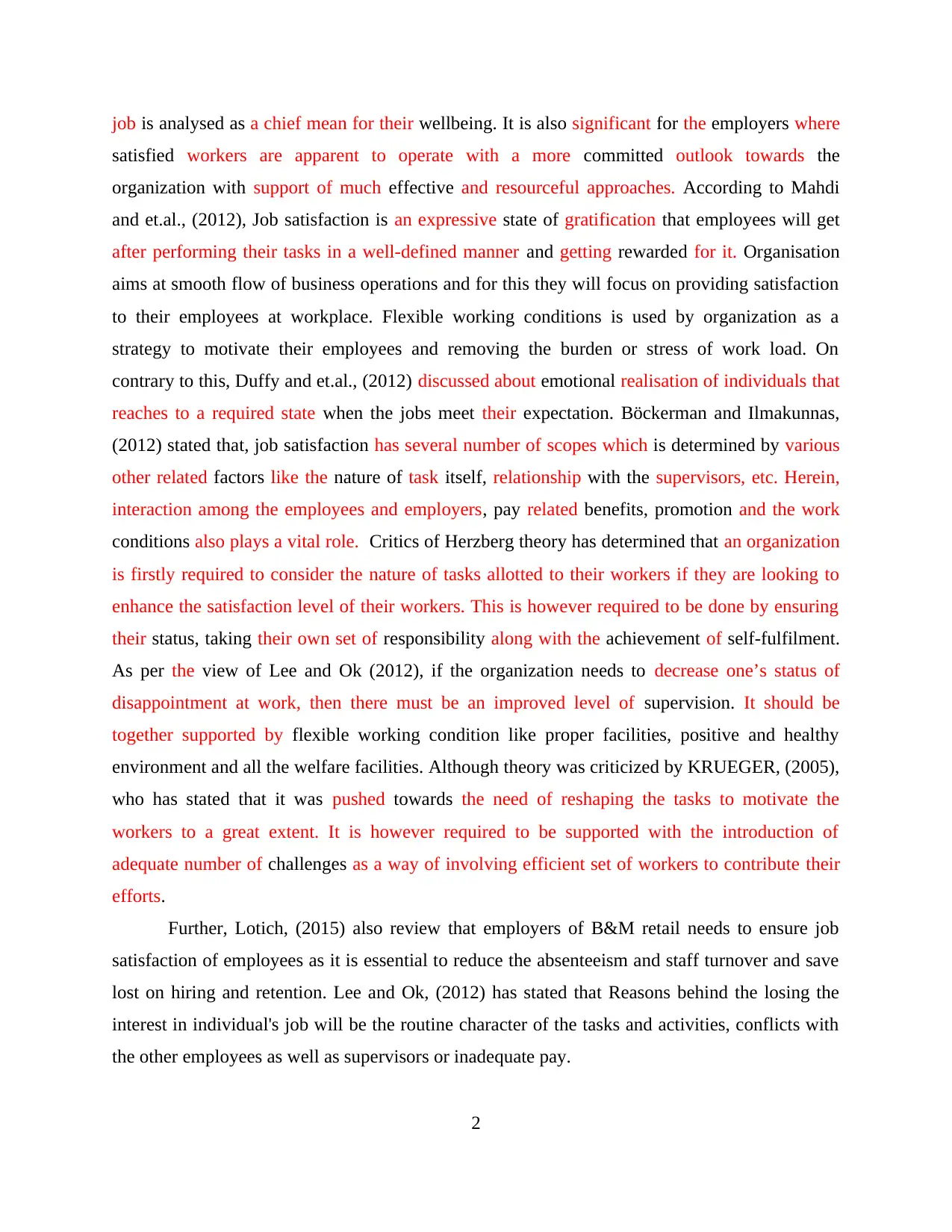
job is analysed as a chief mean for their wellbeing. It is also significant for the employers where
satisfied workers are apparent to operate with a more committed outlook towards the
organization with support of much effective and resourceful approaches. According to Mahdi
and et.al., (2012), Job satisfaction is an expressive state of gratification that employees will get
after performing their tasks in a well-defined manner and getting rewarded for it. Organisation
aims at smooth flow of business operations and for this they will focus on providing satisfaction
to their employees at workplace. Flexible working conditions is used by organization as a
strategy to motivate their employees and removing the burden or stress of work load. On
contrary to this, Duffy and et.al., (2012) discussed about emotional realisation of individuals that
reaches to a required state when the jobs meet their expectation. Böckerman and Ilmakunnas,
(2012) stated that, job satisfaction has several number of scopes which is determined by various
other related factors like the nature of task itself, relationship with the supervisors, etc. Herein,
interaction among the employees and employers, pay related benefits, promotion and the work
conditions also plays a vital role. Critics of Herzberg theory has determined that an organization
is firstly required to consider the nature of tasks allotted to their workers if they are looking to
enhance the satisfaction level of their workers. This is however required to be done by ensuring
their status, taking their own set of responsibility along with the achievement of self-fulfilment.
As per the view of Lee and Ok (2012), if the organization needs to decrease one’s status of
disappointment at work, then there must be an improved level of supervision. It should be
together supported by flexible working condition like proper facilities, positive and healthy
environment and all the welfare facilities. Although theory was criticized by KRUEGER, (2005),
who has stated that it was pushed towards the need of reshaping the tasks to motivate the
workers to a great extent. It is however required to be supported with the introduction of
adequate number of challenges as a way of involving efficient set of workers to contribute their
efforts.
Further, Lotich, (2015) also review that employers of B&M retail needs to ensure job
satisfaction of employees as it is essential to reduce the absenteeism and staff turnover and save
lost on hiring and retention. Lee and Ok, (2012) has stated that Reasons behind the losing the
interest in individual's job will be the routine character of the tasks and activities, conflicts with
the other employees as well as supervisors or inadequate pay.
2
satisfied workers are apparent to operate with a more committed outlook towards the
organization with support of much effective and resourceful approaches. According to Mahdi
and et.al., (2012), Job satisfaction is an expressive state of gratification that employees will get
after performing their tasks in a well-defined manner and getting rewarded for it. Organisation
aims at smooth flow of business operations and for this they will focus on providing satisfaction
to their employees at workplace. Flexible working conditions is used by organization as a
strategy to motivate their employees and removing the burden or stress of work load. On
contrary to this, Duffy and et.al., (2012) discussed about emotional realisation of individuals that
reaches to a required state when the jobs meet their expectation. Böckerman and Ilmakunnas,
(2012) stated that, job satisfaction has several number of scopes which is determined by various
other related factors like the nature of task itself, relationship with the supervisors, etc. Herein,
interaction among the employees and employers, pay related benefits, promotion and the work
conditions also plays a vital role. Critics of Herzberg theory has determined that an organization
is firstly required to consider the nature of tasks allotted to their workers if they are looking to
enhance the satisfaction level of their workers. This is however required to be done by ensuring
their status, taking their own set of responsibility along with the achievement of self-fulfilment.
As per the view of Lee and Ok (2012), if the organization needs to decrease one’s status of
disappointment at work, then there must be an improved level of supervision. It should be
together supported by flexible working condition like proper facilities, positive and healthy
environment and all the welfare facilities. Although theory was criticized by KRUEGER, (2005),
who has stated that it was pushed towards the need of reshaping the tasks to motivate the
workers to a great extent. It is however required to be supported with the introduction of
adequate number of challenges as a way of involving efficient set of workers to contribute their
efforts.
Further, Lotich, (2015) also review that employers of B&M retail needs to ensure job
satisfaction of employees as it is essential to reduce the absenteeism and staff turnover and save
lost on hiring and retention. Lee and Ok, (2012) has stated that Reasons behind the losing the
interest in individual's job will be the routine character of the tasks and activities, conflicts with
the other employees as well as supervisors or inadequate pay.
2
Paraphrase This Document
Need a fresh take? Get an instant paraphrase of this document with our AI Paraphraser
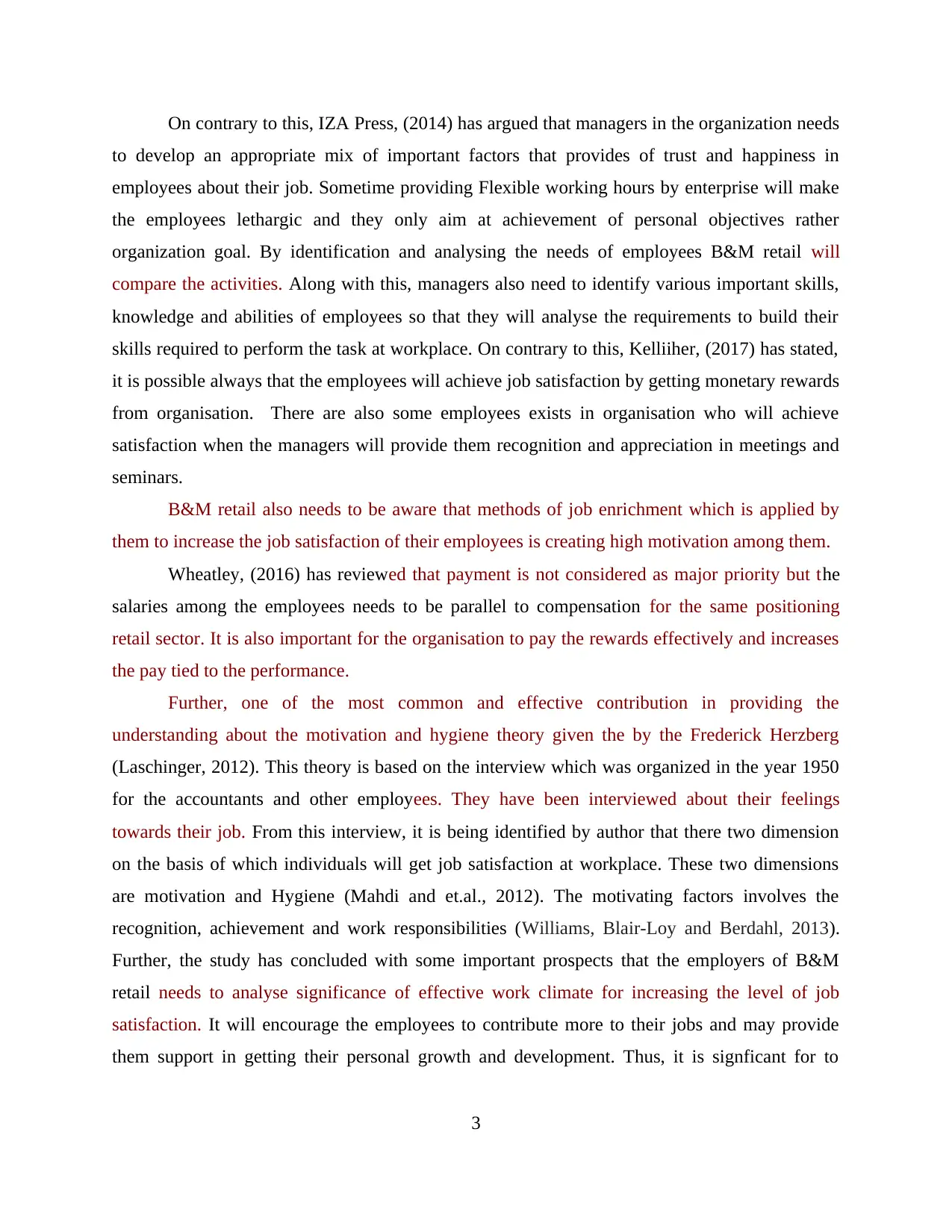
On contrary to this, IZA Press, (2014) has argued that managers in the organization needs
to develop an appropriate mix of important factors that provides of trust and happiness in
employees about their job. Sometime providing Flexible working hours by enterprise will make
the employees lethargic and they only aim at achievement of personal objectives rather
organization goal. By identification and analysing the needs of employees B&M retail will
compare the activities. Along with this, managers also need to identify various important skills,
knowledge and abilities of employees so that they will analyse the requirements to build their
skills required to perform the task at workplace. On contrary to this, Kelliiher, (2017) has stated,
it is possible always that the employees will achieve job satisfaction by getting monetary rewards
from organisation. There are also some employees exists in organisation who will achieve
satisfaction when the managers will provide them recognition and appreciation in meetings and
seminars.
B&M retail also needs to be aware that methods of job enrichment which is applied by
them to increase the job satisfaction of their employees is creating high motivation among them.
Wheatley, (2016) has reviewed that payment is not considered as major priority but the
salaries among the employees needs to be parallel to compensation for the same positioning
retail sector. It is also important for the organisation to pay the rewards effectively and increases
the pay tied to the performance.
Further, one of the most common and effective contribution in providing the
understanding about the motivation and hygiene theory given the by the Frederick Herzberg
(Laschinger, 2012). This theory is based on the interview which was organized in the year 1950
for the accountants and other employees. They have been interviewed about their feelings
towards their job. From this interview, it is being identified by author that there two dimension
on the basis of which individuals will get job satisfaction at workplace. These two dimensions
are motivation and Hygiene (Mahdi and et.al., 2012). The motivating factors involves the
recognition, achievement and work responsibilities (Williams, Blair‐Loy and Berdahl, 2013).
Further, the study has concluded with some important prospects that the employers of B&M
retail needs to analyse significance of effective work climate for increasing the level of job
satisfaction. It will encourage the employees to contribute more to their jobs and may provide
them support in getting their personal growth and development. Thus, it is signficant for to
3
to develop an appropriate mix of important factors that provides of trust and happiness in
employees about their job. Sometime providing Flexible working hours by enterprise will make
the employees lethargic and they only aim at achievement of personal objectives rather
organization goal. By identification and analysing the needs of employees B&M retail will
compare the activities. Along with this, managers also need to identify various important skills,
knowledge and abilities of employees so that they will analyse the requirements to build their
skills required to perform the task at workplace. On contrary to this, Kelliiher, (2017) has stated,
it is possible always that the employees will achieve job satisfaction by getting monetary rewards
from organisation. There are also some employees exists in organisation who will achieve
satisfaction when the managers will provide them recognition and appreciation in meetings and
seminars.
B&M retail also needs to be aware that methods of job enrichment which is applied by
them to increase the job satisfaction of their employees is creating high motivation among them.
Wheatley, (2016) has reviewed that payment is not considered as major priority but the
salaries among the employees needs to be parallel to compensation for the same positioning
retail sector. It is also important for the organisation to pay the rewards effectively and increases
the pay tied to the performance.
Further, one of the most common and effective contribution in providing the
understanding about the motivation and hygiene theory given the by the Frederick Herzberg
(Laschinger, 2012). This theory is based on the interview which was organized in the year 1950
for the accountants and other employees. They have been interviewed about their feelings
towards their job. From this interview, it is being identified by author that there two dimension
on the basis of which individuals will get job satisfaction at workplace. These two dimensions
are motivation and Hygiene (Mahdi and et.al., 2012). The motivating factors involves the
recognition, achievement and work responsibilities (Williams, Blair‐Loy and Berdahl, 2013).
Further, the study has concluded with some important prospects that the employers of B&M
retail needs to analyse significance of effective work climate for increasing the level of job
satisfaction. It will encourage the employees to contribute more to their jobs and may provide
them support in getting their personal growth and development. Thus, it is signficant for to
3
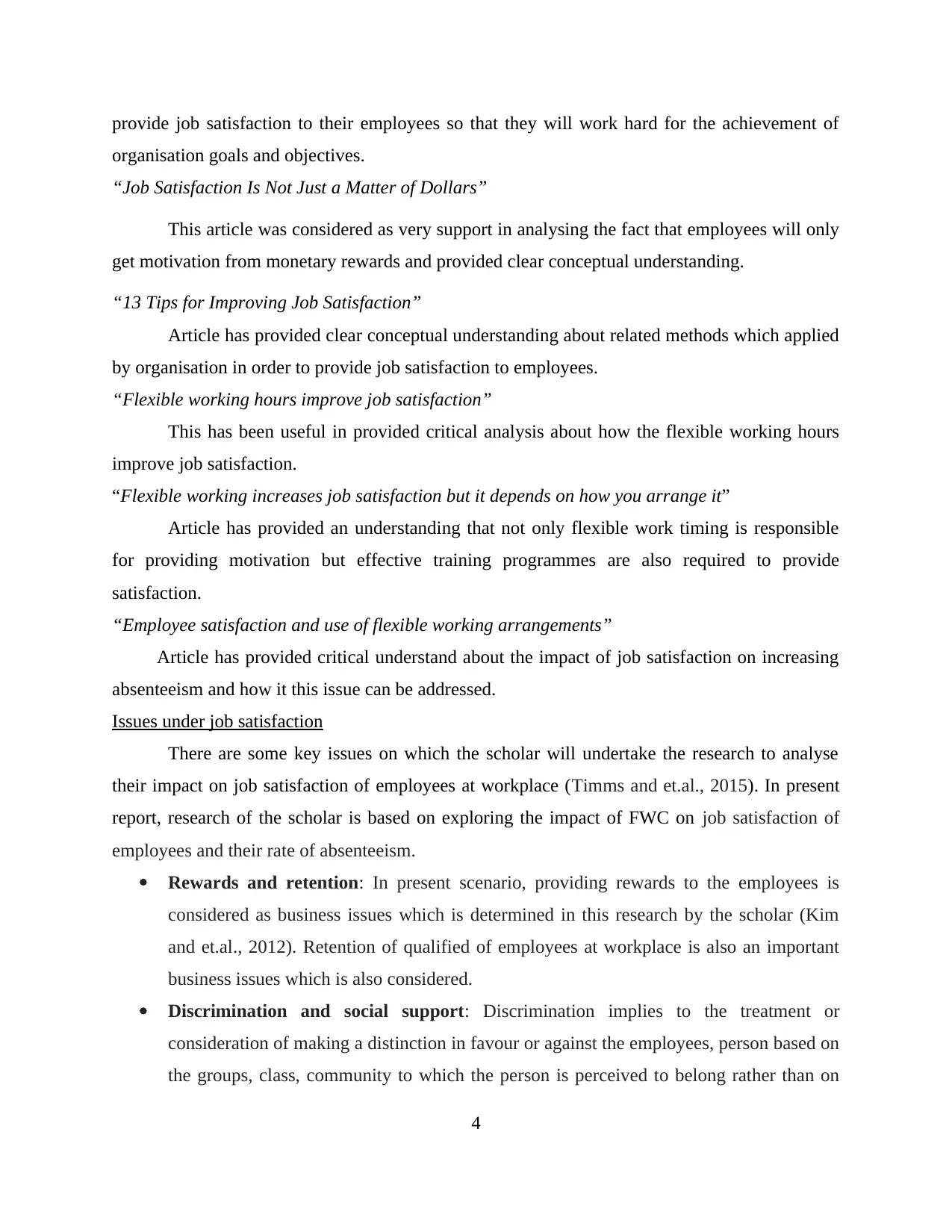
provide job satisfaction to their employees so that they will work hard for the achievement of
organisation goals and objectives.
“Job Satisfaction Is Not Just a Matter of Dollars”
This article was considered as very support in analysing the fact that employees will only
get motivation from monetary rewards and provided clear conceptual understanding.
“13 Tips for Improving Job Satisfaction”
Article has provided clear conceptual understanding about related methods which applied
by organisation in order to provide job satisfaction to employees.
“Flexible working hours improve job satisfaction”
This has been useful in provided critical analysis about how the flexible working hours
improve job satisfaction.
“Flexible working increases job satisfaction but it depends on how you arrange it”
Article has provided an understanding that not only flexible work timing is responsible
for providing motivation but effective training programmes are also required to provide
satisfaction.
“Employee satisfaction and use of flexible working arrangements”
Article has provided critical understand about the impact of job satisfaction on increasing
absenteeism and how it this issue can be addressed.
Issues under job satisfaction
There are some key issues on which the scholar will undertake the research to analyse
their impact on job satisfaction of employees at workplace (Timms and et.al., 2015). In present
report, research of the scholar is based on exploring the impact of FWC on job satisfaction of
employees and their rate of absenteeism.
Rewards and retention: In present scenario, providing rewards to the employees is
considered as business issues which is determined in this research by the scholar (Kim
and et.al., 2012). Retention of qualified of employees at workplace is also an important
business issues which is also considered.
Discrimination and social support: Discrimination implies to the treatment or
consideration of making a distinction in favour or against the employees, person based on
the groups, class, community to which the person is perceived to belong rather than on
4
organisation goals and objectives.
“Job Satisfaction Is Not Just a Matter of Dollars”
This article was considered as very support in analysing the fact that employees will only
get motivation from monetary rewards and provided clear conceptual understanding.
“13 Tips for Improving Job Satisfaction”
Article has provided clear conceptual understanding about related methods which applied
by organisation in order to provide job satisfaction to employees.
“Flexible working hours improve job satisfaction”
This has been useful in provided critical analysis about how the flexible working hours
improve job satisfaction.
“Flexible working increases job satisfaction but it depends on how you arrange it”
Article has provided an understanding that not only flexible work timing is responsible
for providing motivation but effective training programmes are also required to provide
satisfaction.
“Employee satisfaction and use of flexible working arrangements”
Article has provided critical understand about the impact of job satisfaction on increasing
absenteeism and how it this issue can be addressed.
Issues under job satisfaction
There are some key issues on which the scholar will undertake the research to analyse
their impact on job satisfaction of employees at workplace (Timms and et.al., 2015). In present
report, research of the scholar is based on exploring the impact of FWC on job satisfaction of
employees and their rate of absenteeism.
Rewards and retention: In present scenario, providing rewards to the employees is
considered as business issues which is determined in this research by the scholar (Kim
and et.al., 2012). Retention of qualified of employees at workplace is also an important
business issues which is also considered.
Discrimination and social support: Discrimination implies to the treatment or
consideration of making a distinction in favour or against the employees, person based on
the groups, class, community to which the person is perceived to belong rather than on
4
⊘ This is a preview!⊘
Do you want full access?
Subscribe today to unlock all pages.

Trusted by 1+ million students worldwide
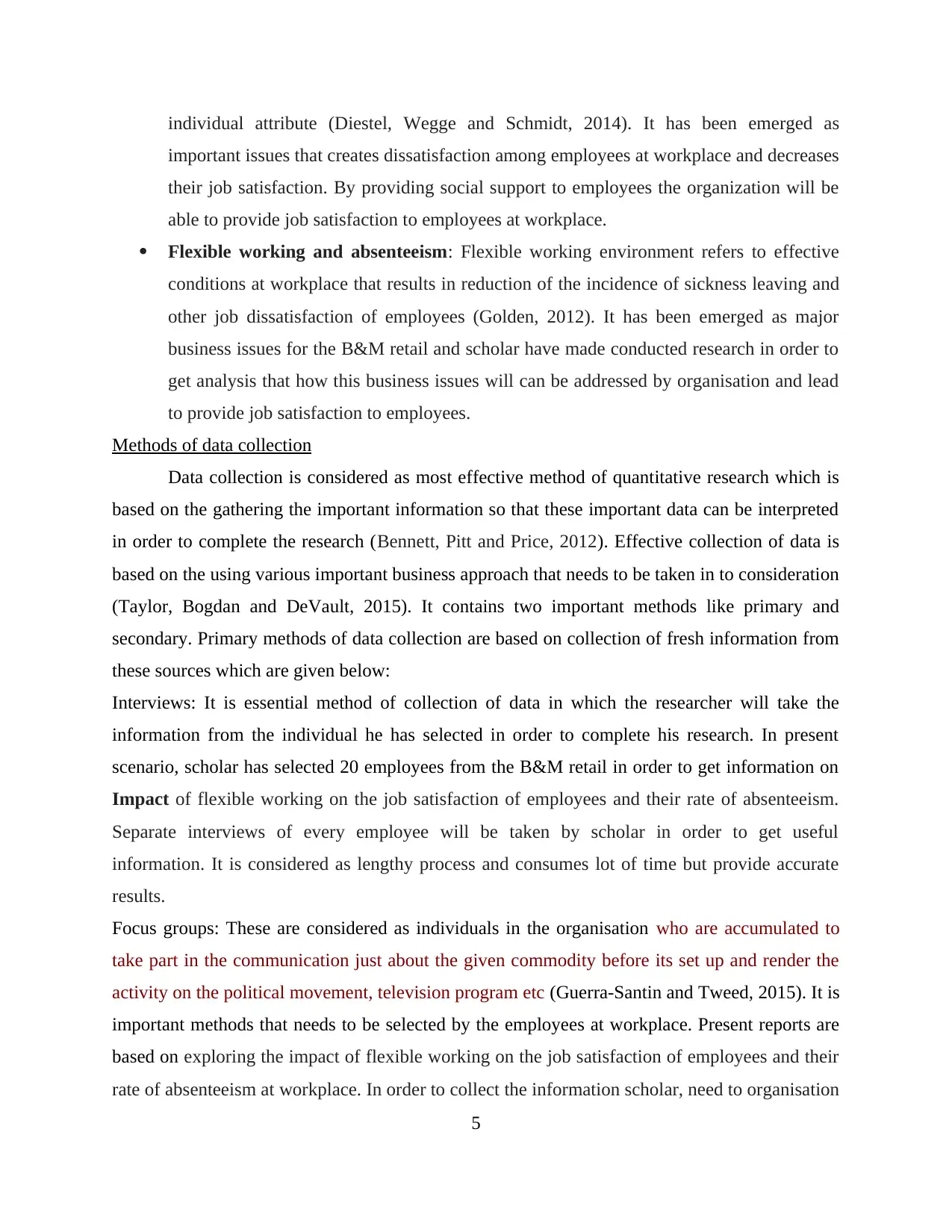
individual attribute (Diestel, Wegge and Schmidt, 2014). It has been emerged as
important issues that creates dissatisfaction among employees at workplace and decreases
their job satisfaction. By providing social support to employees the organization will be
able to provide job satisfaction to employees at workplace.
Flexible working and absenteeism: Flexible working environment refers to effective
conditions at workplace that results in reduction of the incidence of sickness leaving and
other job dissatisfaction of employees (Golden, 2012). It has been emerged as major
business issues for the B&M retail and scholar have made conducted research in order to
get analysis that how this business issues will can be addressed by organisation and lead
to provide job satisfaction to employees.
Methods of data collection
Data collection is considered as most effective method of quantitative research which is
based on the gathering the important information so that these important data can be interpreted
in order to complete the research (Bennett, Pitt and Price, 2012). Effective collection of data is
based on the using various important business approach that needs to be taken in to consideration
(Taylor, Bogdan and DeVault, 2015). It contains two important methods like primary and
secondary. Primary methods of data collection are based on collection of fresh information from
these sources which are given below:
Interviews: It is essential method of collection of data in which the researcher will take the
information from the individual he has selected in order to complete his research. In present
scenario, scholar has selected 20 employees from the B&M retail in order to get information on
Impact of flexible working on the job satisfaction of employees and their rate of absenteeism.
Separate interviews of every employee will be taken by scholar in order to get useful
information. It is considered as lengthy process and consumes lot of time but provide accurate
results.
Focus groups: These are considered as individuals in the organisation who are accumulated to
take part in the communication just about the given commodity before its set up and render the
activity on the political movement, television program etc (Guerra-Santin and Tweed, 2015). It is
important methods that needs to be selected by the employees at workplace. Present reports are
based on exploring the impact of flexible working on the job satisfaction of employees and their
rate of absenteeism at workplace. In order to collect the information scholar, need to organisation
5
important issues that creates dissatisfaction among employees at workplace and decreases
their job satisfaction. By providing social support to employees the organization will be
able to provide job satisfaction to employees at workplace.
Flexible working and absenteeism: Flexible working environment refers to effective
conditions at workplace that results in reduction of the incidence of sickness leaving and
other job dissatisfaction of employees (Golden, 2012). It has been emerged as major
business issues for the B&M retail and scholar have made conducted research in order to
get analysis that how this business issues will can be addressed by organisation and lead
to provide job satisfaction to employees.
Methods of data collection
Data collection is considered as most effective method of quantitative research which is
based on the gathering the important information so that these important data can be interpreted
in order to complete the research (Bennett, Pitt and Price, 2012). Effective collection of data is
based on the using various important business approach that needs to be taken in to consideration
(Taylor, Bogdan and DeVault, 2015). It contains two important methods like primary and
secondary. Primary methods of data collection are based on collection of fresh information from
these sources which are given below:
Interviews: It is essential method of collection of data in which the researcher will take the
information from the individual he has selected in order to complete his research. In present
scenario, scholar has selected 20 employees from the B&M retail in order to get information on
Impact of flexible working on the job satisfaction of employees and their rate of absenteeism.
Separate interviews of every employee will be taken by scholar in order to get useful
information. It is considered as lengthy process and consumes lot of time but provide accurate
results.
Focus groups: These are considered as individuals in the organisation who are accumulated to
take part in the communication just about the given commodity before its set up and render the
activity on the political movement, television program etc (Guerra-Santin and Tweed, 2015). It is
important methods that needs to be selected by the employees at workplace. Present reports are
based on exploring the impact of flexible working on the job satisfaction of employees and their
rate of absenteeism at workplace. In order to collect the information scholar, need to organisation
5
Paraphrase This Document
Need a fresh take? Get an instant paraphrase of this document with our AI Paraphraser
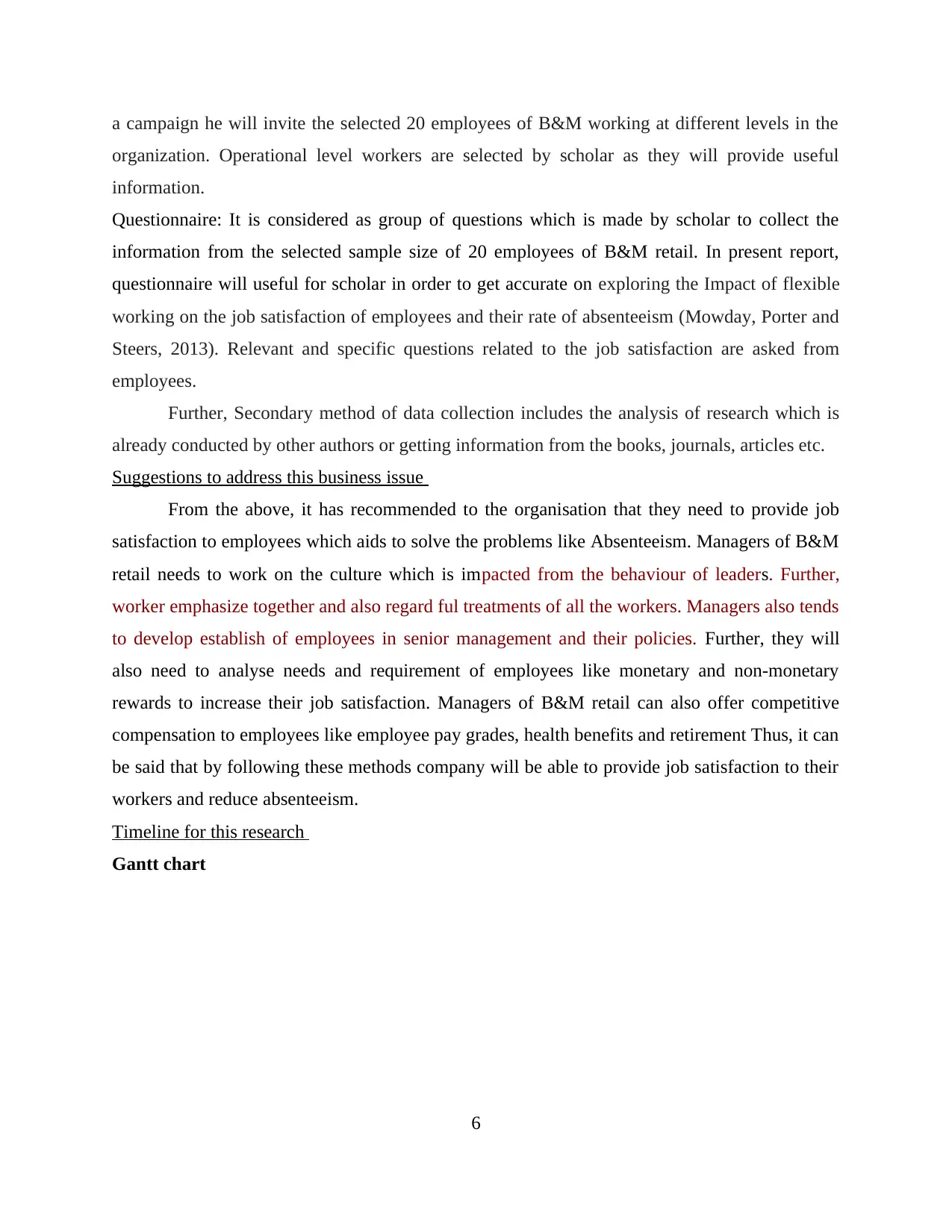
a campaign he will invite the selected 20 employees of B&M working at different levels in the
organization. Operational level workers are selected by scholar as they will provide useful
information.
Questionnaire: It is considered as group of questions which is made by scholar to collect the
information from the selected sample size of 20 employees of B&M retail. In present report,
questionnaire will useful for scholar in order to get accurate on exploring the Impact of flexible
working on the job satisfaction of employees and their rate of absenteeism (Mowday, Porter and
Steers, 2013). Relevant and specific questions related to the job satisfaction are asked from
employees.
Further, Secondary method of data collection includes the analysis of research which is
already conducted by other authors or getting information from the books, journals, articles etc.
Suggestions to address this business issue
From the above, it has recommended to the organisation that they need to provide job
satisfaction to employees which aids to solve the problems like Absenteeism. Managers of B&M
retail needs to work on the culture which is impacted from the behaviour of leaders. Further,
worker emphasize together and also regard ful treatments of all the workers. Managers also tends
to develop establish of employees in senior management and their policies. Further, they will
also need to analyse needs and requirement of employees like monetary and non-monetary
rewards to increase their job satisfaction. Managers of B&M retail can also offer competitive
compensation to employees like employee pay grades, health benefits and retirement Thus, it can
be said that by following these methods company will be able to provide job satisfaction to their
workers and reduce absenteeism.
Timeline for this research
Gantt chart
6
organization. Operational level workers are selected by scholar as they will provide useful
information.
Questionnaire: It is considered as group of questions which is made by scholar to collect the
information from the selected sample size of 20 employees of B&M retail. In present report,
questionnaire will useful for scholar in order to get accurate on exploring the Impact of flexible
working on the job satisfaction of employees and their rate of absenteeism (Mowday, Porter and
Steers, 2013). Relevant and specific questions related to the job satisfaction are asked from
employees.
Further, Secondary method of data collection includes the analysis of research which is
already conducted by other authors or getting information from the books, journals, articles etc.
Suggestions to address this business issue
From the above, it has recommended to the organisation that they need to provide job
satisfaction to employees which aids to solve the problems like Absenteeism. Managers of B&M
retail needs to work on the culture which is impacted from the behaviour of leaders. Further,
worker emphasize together and also regard ful treatments of all the workers. Managers also tends
to develop establish of employees in senior management and their policies. Further, they will
also need to analyse needs and requirement of employees like monetary and non-monetary
rewards to increase their job satisfaction. Managers of B&M retail can also offer competitive
compensation to employees like employee pay grades, health benefits and retirement Thus, it can
be said that by following these methods company will be able to provide job satisfaction to their
workers and reduce absenteeism.
Timeline for this research
Gantt chart
6
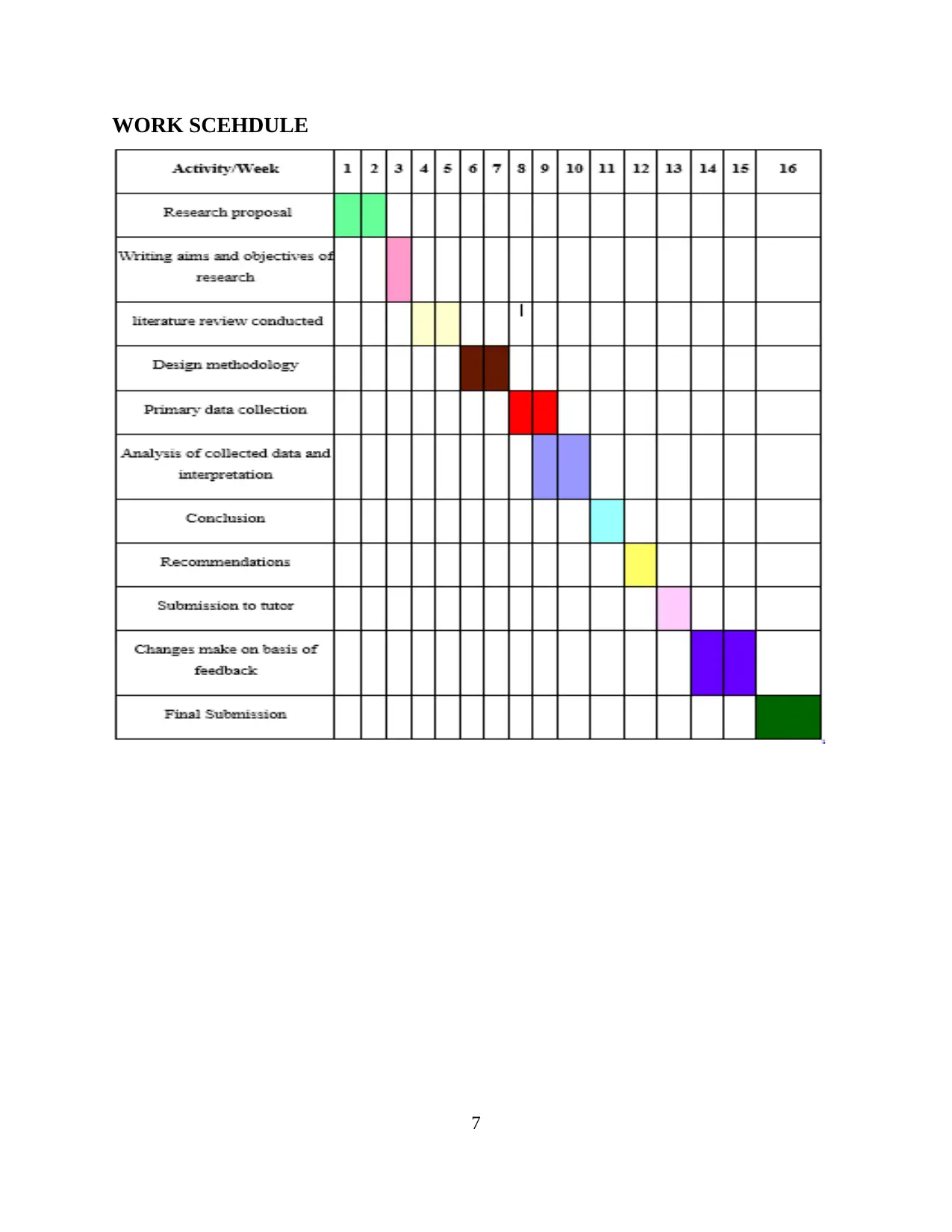
WORK SCEHDULE
7
7
⊘ This is a preview!⊘
Do you want full access?
Subscribe today to unlock all pages.

Trusted by 1+ million students worldwide
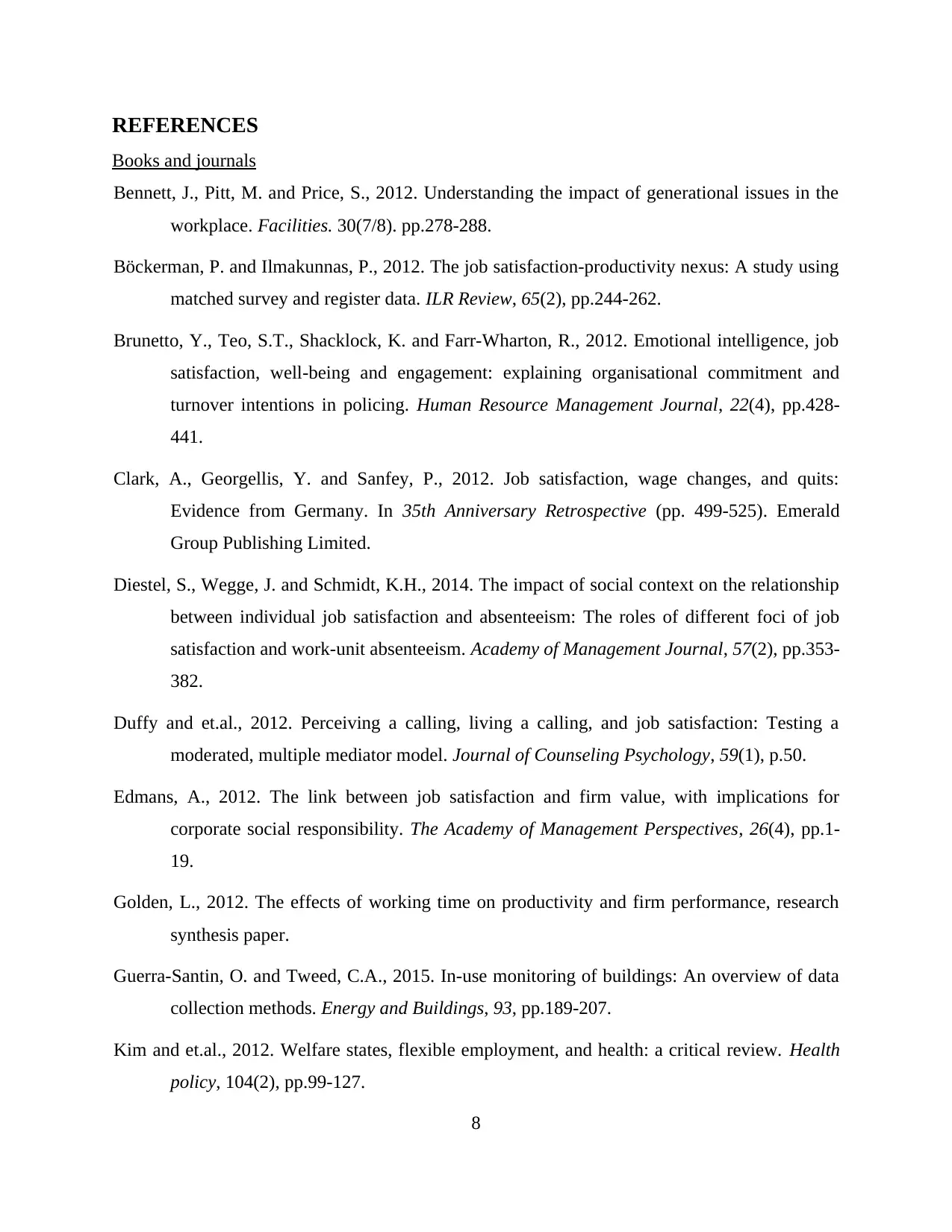
REFERENCES
Books and journals
Bennett, J., Pitt, M. and Price, S., 2012. Understanding the impact of generational issues in the
workplace. Facilities. 30(7/8). pp.278-288.
Böckerman, P. and Ilmakunnas, P., 2012. The job satisfaction-productivity nexus: A study using
matched survey and register data. ILR Review, 65(2), pp.244-262.
Brunetto, Y., Teo, S.T., Shacklock, K. and Farr‐Wharton, R., 2012. Emotional intelligence, job
satisfaction, well‐being and engagement: explaining organisational commitment and
turnover intentions in policing. Human Resource Management Journal, 22(4), pp.428-
441.
Clark, A., Georgellis, Y. and Sanfey, P., 2012. Job satisfaction, wage changes, and quits:
Evidence from Germany. In 35th Anniversary Retrospective (pp. 499-525). Emerald
Group Publishing Limited.
Diestel, S., Wegge, J. and Schmidt, K.H., 2014. The impact of social context on the relationship
between individual job satisfaction and absenteeism: The roles of different foci of job
satisfaction and work-unit absenteeism. Academy of Management Journal, 57(2), pp.353-
382.
Duffy and et.al., 2012. Perceiving a calling, living a calling, and job satisfaction: Testing a
moderated, multiple mediator model. Journal of Counseling Psychology, 59(1), p.50.
Edmans, A., 2012. The link between job satisfaction and firm value, with implications for
corporate social responsibility. The Academy of Management Perspectives, 26(4), pp.1-
19.
Golden, L., 2012. The effects of working time on productivity and firm performance, research
synthesis paper.
Guerra-Santin, O. and Tweed, C.A., 2015. In-use monitoring of buildings: An overview of data
collection methods. Energy and Buildings, 93, pp.189-207.
Kim and et.al., 2012. Welfare states, flexible employment, and health: a critical review. Health
policy, 104(2), pp.99-127.
8
Books and journals
Bennett, J., Pitt, M. and Price, S., 2012. Understanding the impact of generational issues in the
workplace. Facilities. 30(7/8). pp.278-288.
Böckerman, P. and Ilmakunnas, P., 2012. The job satisfaction-productivity nexus: A study using
matched survey and register data. ILR Review, 65(2), pp.244-262.
Brunetto, Y., Teo, S.T., Shacklock, K. and Farr‐Wharton, R., 2012. Emotional intelligence, job
satisfaction, well‐being and engagement: explaining organisational commitment and
turnover intentions in policing. Human Resource Management Journal, 22(4), pp.428-
441.
Clark, A., Georgellis, Y. and Sanfey, P., 2012. Job satisfaction, wage changes, and quits:
Evidence from Germany. In 35th Anniversary Retrospective (pp. 499-525). Emerald
Group Publishing Limited.
Diestel, S., Wegge, J. and Schmidt, K.H., 2014. The impact of social context on the relationship
between individual job satisfaction and absenteeism: The roles of different foci of job
satisfaction and work-unit absenteeism. Academy of Management Journal, 57(2), pp.353-
382.
Duffy and et.al., 2012. Perceiving a calling, living a calling, and job satisfaction: Testing a
moderated, multiple mediator model. Journal of Counseling Psychology, 59(1), p.50.
Edmans, A., 2012. The link between job satisfaction and firm value, with implications for
corporate social responsibility. The Academy of Management Perspectives, 26(4), pp.1-
19.
Golden, L., 2012. The effects of working time on productivity and firm performance, research
synthesis paper.
Guerra-Santin, O. and Tweed, C.A., 2015. In-use monitoring of buildings: An overview of data
collection methods. Energy and Buildings, 93, pp.189-207.
Kim and et.al., 2012. Welfare states, flexible employment, and health: a critical review. Health
policy, 104(2), pp.99-127.
8
Paraphrase This Document
Need a fresh take? Get an instant paraphrase of this document with our AI Paraphraser
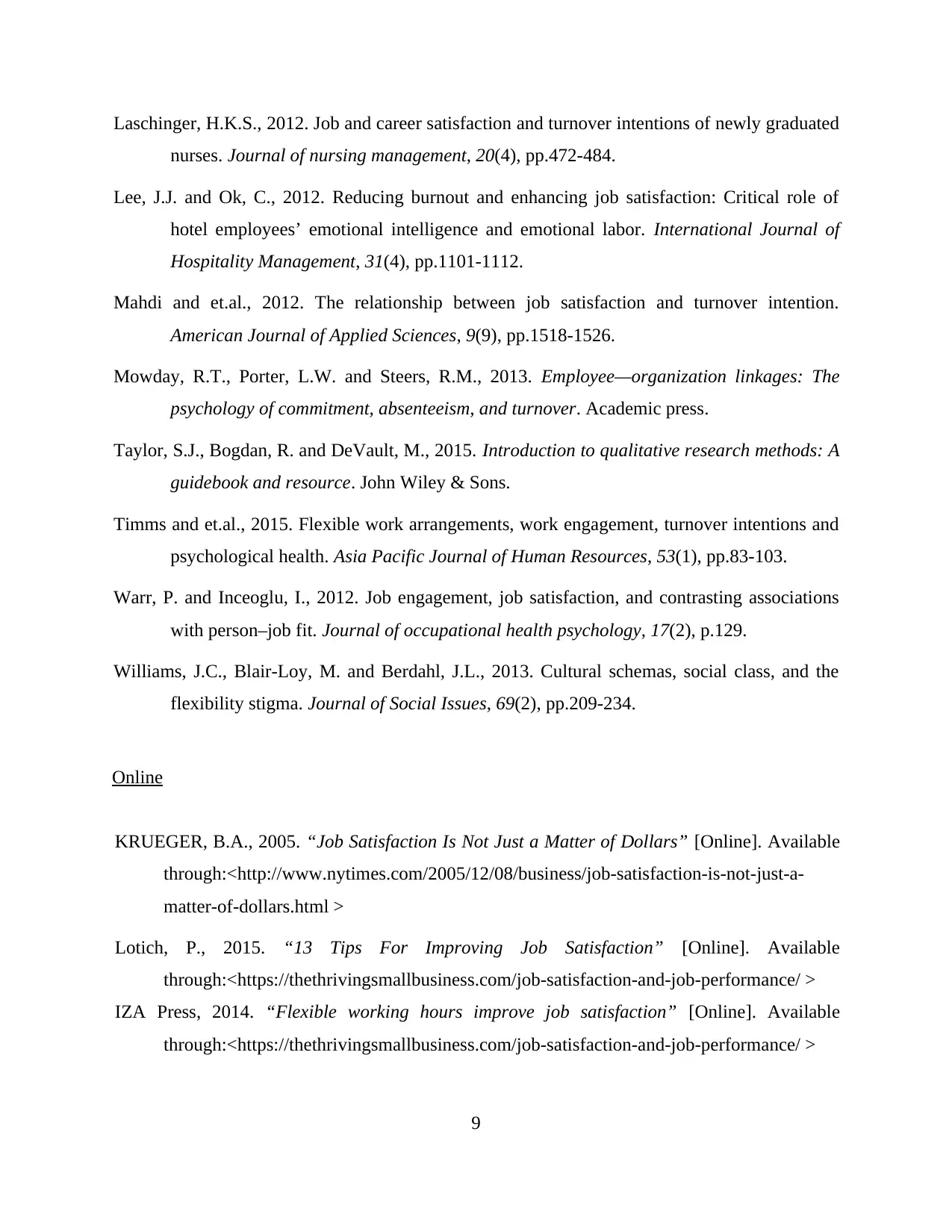
Laschinger, H.K.S., 2012. Job and career satisfaction and turnover intentions of newly graduated
nurses. Journal of nursing management, 20(4), pp.472-484.
Lee, J.J. and Ok, C., 2012. Reducing burnout and enhancing job satisfaction: Critical role of
hotel employees’ emotional intelligence and emotional labor. International Journal of
Hospitality Management, 31(4), pp.1101-1112.
Mahdi and et.al., 2012. The relationship between job satisfaction and turnover intention.
American Journal of Applied Sciences, 9(9), pp.1518-1526.
Mowday, R.T., Porter, L.W. and Steers, R.M., 2013. Employee—organization linkages: The
psychology of commitment, absenteeism, and turnover. Academic press.
Taylor, S.J., Bogdan, R. and DeVault, M., 2015. Introduction to qualitative research methods: A
guidebook and resource. John Wiley & Sons.
Timms and et.al., 2015. Flexible work arrangements, work engagement, turnover intentions and
psychological health. Asia Pacific Journal of Human Resources, 53(1), pp.83-103.
Warr, P. and Inceoglu, I., 2012. Job engagement, job satisfaction, and contrasting associations
with person–job fit. Journal of occupational health psychology, 17(2), p.129.
Williams, J.C., Blair‐Loy, M. and Berdahl, J.L., 2013. Cultural schemas, social class, and the
flexibility stigma. Journal of Social Issues, 69(2), pp.209-234.
Online
KRUEGER, B.A., 2005. “Job Satisfaction Is Not Just a Matter of Dollars” [Online]. Available
through:<http://www.nytimes.com/2005/12/08/business/job-satisfaction-is-not-just-a-
matter-of-dollars.html >
Lotich, P., 2015. “13 Tips For Improving Job Satisfaction” [Online]. Available
through:<https://thethrivingsmallbusiness.com/job-satisfaction-and-job-performance/ >
IZA Press, 2014. “Flexible working hours improve job satisfaction” [Online]. Available
through:<https://thethrivingsmallbusiness.com/job-satisfaction-and-job-performance/ >
9
nurses. Journal of nursing management, 20(4), pp.472-484.
Lee, J.J. and Ok, C., 2012. Reducing burnout and enhancing job satisfaction: Critical role of
hotel employees’ emotional intelligence and emotional labor. International Journal of
Hospitality Management, 31(4), pp.1101-1112.
Mahdi and et.al., 2012. The relationship between job satisfaction and turnover intention.
American Journal of Applied Sciences, 9(9), pp.1518-1526.
Mowday, R.T., Porter, L.W. and Steers, R.M., 2013. Employee—organization linkages: The
psychology of commitment, absenteeism, and turnover. Academic press.
Taylor, S.J., Bogdan, R. and DeVault, M., 2015. Introduction to qualitative research methods: A
guidebook and resource. John Wiley & Sons.
Timms and et.al., 2015. Flexible work arrangements, work engagement, turnover intentions and
psychological health. Asia Pacific Journal of Human Resources, 53(1), pp.83-103.
Warr, P. and Inceoglu, I., 2012. Job engagement, job satisfaction, and contrasting associations
with person–job fit. Journal of occupational health psychology, 17(2), p.129.
Williams, J.C., Blair‐Loy, M. and Berdahl, J.L., 2013. Cultural schemas, social class, and the
flexibility stigma. Journal of Social Issues, 69(2), pp.209-234.
Online
KRUEGER, B.A., 2005. “Job Satisfaction Is Not Just a Matter of Dollars” [Online]. Available
through:<http://www.nytimes.com/2005/12/08/business/job-satisfaction-is-not-just-a-
matter-of-dollars.html >
Lotich, P., 2015. “13 Tips For Improving Job Satisfaction” [Online]. Available
through:<https://thethrivingsmallbusiness.com/job-satisfaction-and-job-performance/ >
IZA Press, 2014. “Flexible working hours improve job satisfaction” [Online]. Available
through:<https://thethrivingsmallbusiness.com/job-satisfaction-and-job-performance/ >
9
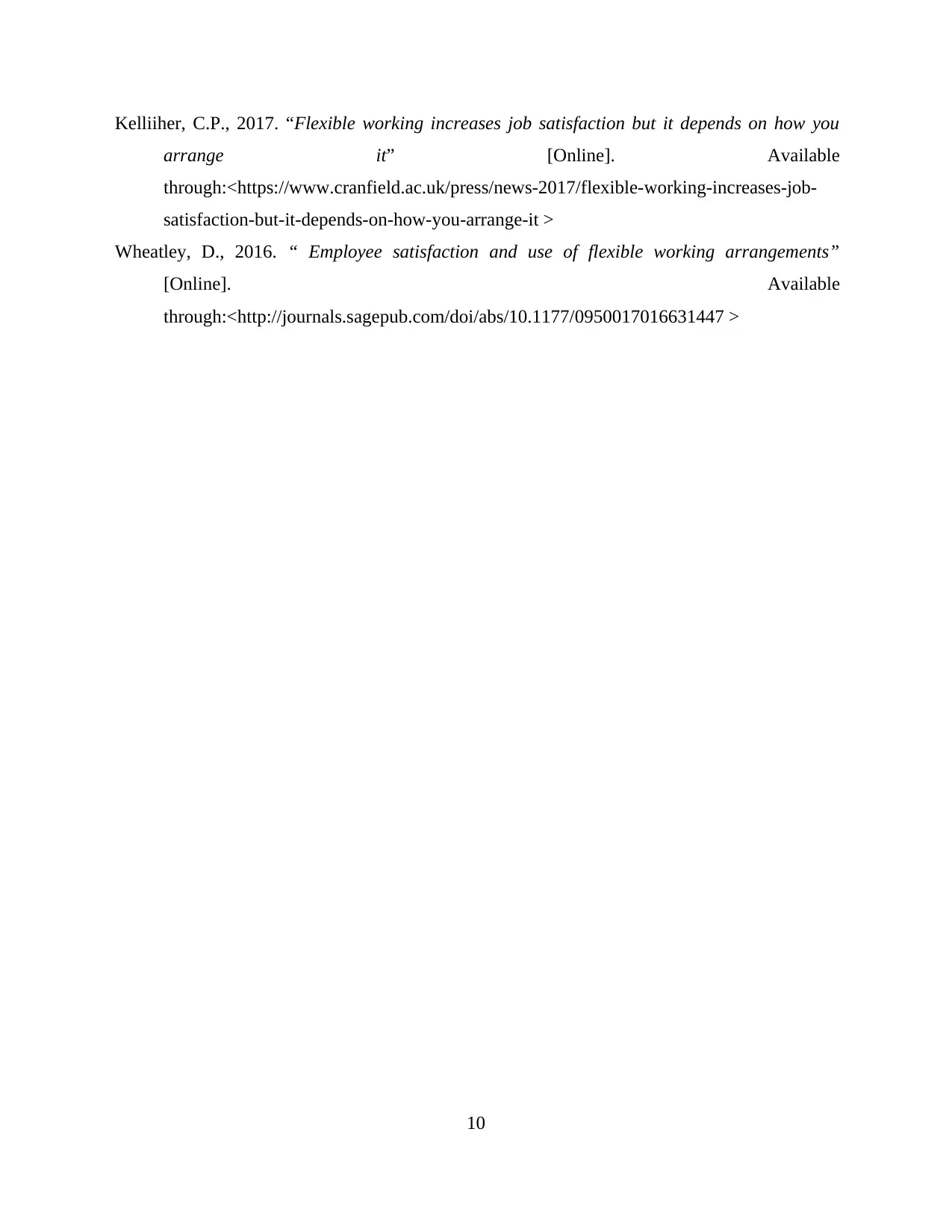
Kelliiher, C.P., 2017. “Flexible working increases job satisfaction but it depends on how you
arrange it” [Online]. Available
through:<https://www.cranfield.ac.uk/press/news-2017/flexible-working-increases-job-
satisfaction-but-it-depends-on-how-you-arrange-it >
Wheatley, D., 2016. “ Employee satisfaction and use of flexible working arrangements”
[Online]. Available
through:<http://journals.sagepub.com/doi/abs/10.1177/0950017016631447 >
10
arrange it” [Online]. Available
through:<https://www.cranfield.ac.uk/press/news-2017/flexible-working-increases-job-
satisfaction-but-it-depends-on-how-you-arrange-it >
Wheatley, D., 2016. “ Employee satisfaction and use of flexible working arrangements”
[Online]. Available
through:<http://journals.sagepub.com/doi/abs/10.1177/0950017016631447 >
10
⊘ This is a preview!⊘
Do you want full access?
Subscribe today to unlock all pages.

Trusted by 1+ million students worldwide
1 out of 12
Related Documents
Your All-in-One AI-Powered Toolkit for Academic Success.
+13062052269
info@desklib.com
Available 24*7 on WhatsApp / Email
![[object Object]](/_next/static/media/star-bottom.7253800d.svg)
Unlock your academic potential
Copyright © 2020–2025 A2Z Services. All Rights Reserved. Developed and managed by ZUCOL.





